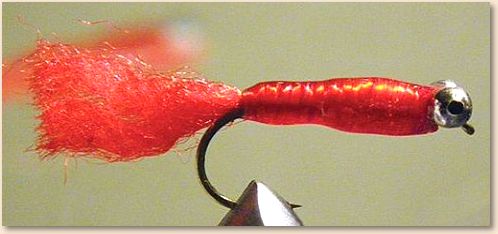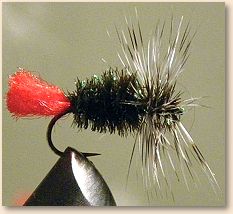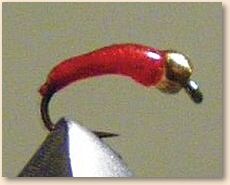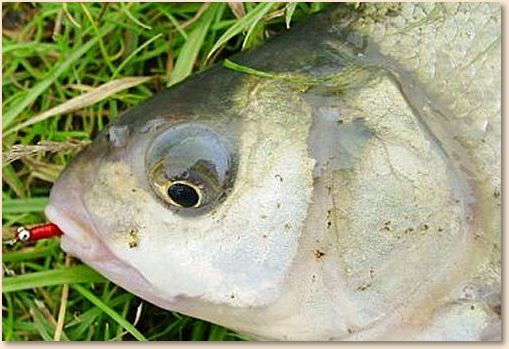|
Editors Note: René is part of the Fly Anglers OnLine
family. I 'speak' with him on the FAOL Chat Room site every
so often. He wrote this article about the use of red with flies and
sent it to me. He does not write in English so he used a computer
software to translate his article from Dutch to English. I then asked
him if I could edit the article to conform a little more to how we
use the English language. He agreed and this is the end result.
Why are brothels in red light, and why are red dresses bold? Why is
red lipstick considered exciting? It is because the color Red has an
effect! And, with simply red, I don't mean the popular pop group
from England. The color red has a big influence on people. But, not
only on mankind, also on fish! So, I titled this, Simply Red …
Why then simply red?
To start with, we generally have quite a lot of red around us when
we look at fishing lures. Take spinners and plugs for instance, with
such a large variety of models and colors available, one of the colors
almost always present that is quite striking, is the color red. The
same goes with us fly fisherman, we frequently find this color in
our wonderful creations of flies, whether wet or dry, nymph or
streamers.
Some examples are the classic Red tag, San Juan worm, and a red
fluor-Nymphs, and many others.
The Red Tag fly with that small piece of red wool or poly-yarn is
pretty easy for us to see at a distance. We can even change the
colors to fluorescent, like red-green or yellow. The Red Tag Nymph,
what does it imitate? A larva of a mosquito, or something else? Who
knows. But the Red Tag nymph works, with a bead or without. The
fish strikes, your line draws tight and you know you have a big fish
on your hook. Almost everyone has seen it during our fishing hours.
But that red,…What is happens when red is on a fly? Many
fishermen among us will have to agree that sometimes when a single
form of red is present or even a lot of red is present on our fly or
Nymph, that sometimes better results are achieved than when the
red was not present.
The question is, can a fish see colors … or the fish distinguish
colors? A number of factors play into this issue as to the clarity of
the water and what depth we fish with our imitation. Research has
clearly shown that, for example, the bream takes red imitations
first instead of white. What do fish see? A small scientific
explanation of this whole is as follows.
What a fish exactly sees depends on the type of sensory cells
in their eyes. There are two different types: one type of record
weak light and the other strong light and color. Fishing on a larger
depth of life, where all the bad lighting conditions is difficult to
observe and uniform in color, have almost exclusively sensory
cells of the weak light type, while fish to the surface or in shallow
water life many cells of the second type, they can not only see better,
but also distinguish colors.
Colors show. What colors a fish (species) can distinguish
depends on the depth and type of habitat. The sunlight has an
initial broad composition so that fish in shallow water (to about 10 m)
almost always are trichromatic.
In sea water the blue light penetrates (short wavelength, about 400 nm)
but more so in fish - as they go deeper - the sensitivity to longer
wavelengths (red - orange - green, 500-600 nm) are missing.
In fresh and turbid water, it is the other way: blue light is the first
to be eliminated in greater depth so fish are more sensitive to longer
wavelengths (red and green).
This has nothing to do with the refractive index of water, but by
scattering molecules (in salt water (Rayleigh scatter) and absorption
by organic matter (in turbid fresh water).
Young fish and species in shallow water are often sensitive to UV.
Infrared observation. Under infrared in this case means the far-red
(remote control, security) of about 800 nm. There are fish species
with a greater sensitivity to longer wavelengths than humans can
perceive. This sensitivity has to do with a special composition of
visual pigment., number of rods and cones.
Rods and cones. For most species is that they initially only have cones.
During growth, this number is increasing and developing the bars with
great speed. Eventually, the number of sticks so much bigger. Numbers
of receptors (cones and rods) is therefore with the size of the eye and
can vary between species. In addition, the numbers within the retina,
where most cones are in that part of the retina of the fish forward
looking.
When we fish in fresh water, like many of us do, then that red
color is clear to see our brothers and sisters there under the water.
To the eyes of the fish, red is very sensitive. Immediately followed
by the colors orange and yellow.
Science does not stand still and further research is ongoing.
One of the latest studies indicate that fish that are down deep
in the sea can indeed see the color red as the color red. The
scientists looked at a color filter, and saw under water suddenly
a spectrum of red around them. Normally, the deep red color is
black. This discovery has shocked some scientists in the world
of the ichthyologist (fish expert). Further scientific research will
disclose even more 'secrets' .
Personally, I fish regularly with a red Nymph and/or a small red
mini-streamer. Roach, (Fish called roach are members of the carp
and minnow family Cyprinidae), bass, and even bream are often
caught with a little red mini streamer. Yes, bass, a lot of bass have
been caught with that little red sock (the mini-streamer). On a
warm summer evening, this is really literally a winner.
Anything can be used as red: wool, ibis, and so many plastic materials.
Red has an effect! It is known that in Roman times around the 3rd
century AD, they used hooks which were bound with red wool.
Here in the Netherlands where I live, I cast my fly line and have
great fun with this wonderful sport known as fishing.
I love … a setting sun, a fighting bass causing rippling waves .
Oh, is it good to be a fly fisherman.
Say, do you think it when you tie? Don't forget the color red.
You will not regret it. ~ Rene van de Ruit
Additional info:

Red mini streamer - Tiemco 5230 #10

Hexe tiemco - Tiemco 5230 #14

Red mini Nymphe - Tiemco 2487 #22



|






